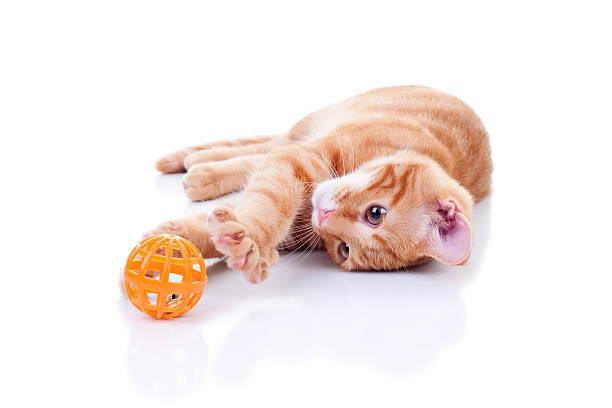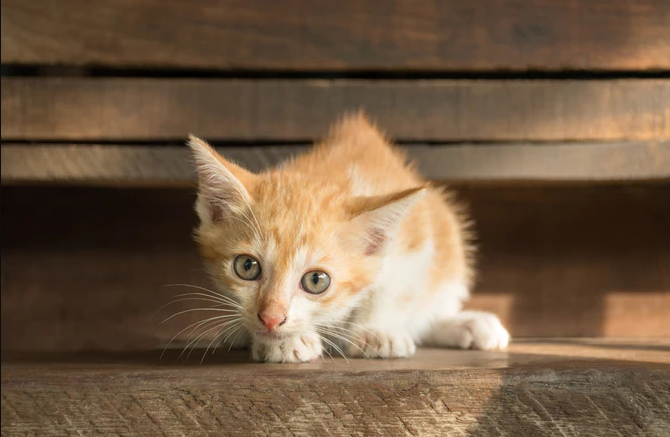First-time cat owners fantasize about a cat who will always be up for a snuggle, ready to give physical affection at any given moment. But once you get your first cat, you quickly realize that not all cats like the human touch. Instead, cats can be raised to be cuddly if given enough attention and affection from a young age.
Hence, we can confidently state that it is not impossible to condition your kitty to be cuddly. Behavioral research has proven that it is possible to raise your cat to enjoy your touch with specific treatment and techniques. The key to raising a cuddly cat is to shower them with love, and attention and handle them from a young age.
Cats are proud creatures who give and take physical affection on their terms, so you want to give them their space too. Play with them enough; bait your kitten into coming out of hiding. But be careful not to scare them and try to understand him so you can cater to his needs. As a pet owner, it is vital to be observant of a pet’s behavior.
Hence, it is better to learn how to raise a kitten who loves petting and cuddling before rushing to the pound.
12 Tips for Raising A Sweet, Cuddly Cat

1. Access To Mommy Cat
Separating litter from the mother is a controversial topic. Many sources will bring different results, but it is best to let your kitten spend the first eight weeks with the mother and siblings. Unfortunately, this cannot always be done as many kittens are separated as soon as they are born.
However, it is healthy for cats to spend the first two months of their life with their litter and mother. This helps the cat develop social skills, and of course, the added nutrition from their mother’s milk adds to their physical development.
2. Welcoming Party for the New Kitten
Getting a kitten is just like preparing for a baby. It would help if you were ready before the kitten arrives. Make sure you have its bed ready as well as a food and water dish, litter box, and enough toys to keep them busy.
In addition, you might want to invest in sufficient cat treats to reward good cat behaviour.
You want your kitten to feel comfortable, safe, and of course, loved when he moves in with you.
So, it would be best if you educated yourself on all things kitten. Then, if you have everything ready before getting your kitten, you will be able to give him the attention he needs.
3. Dealing with a Shy Kitten
It is usual for your kitten to feel shy and try to hide. They hide because they feel scared in a new environment. They can hide due to overstimulation and fear of humans, but it is not suitable for them to hide for too long. It would help if you found a way to make your kitten trust you. It would help if you coaxed the kitten out of hiding.
Try to help your kitten socialize using a variety of bait. Then, one by one, try to occupy or inconvenience her hiding places; for example, block the space under your bed or desk with pillows.
However, ensure you do not block off all the hiding places at once, or you may scare her even more.
Gradually blocking out the hiding spaces will push your kitten to spend time out in the open and even start playing. When you have coaxed your kitten out of its hiding spot, you can start rewarding them. You want to avoid feeding them in their hiding spot.
Instead, please encourage them to stay out in the open by giving treats or food.
According to Jackson Galaxy, a cat expert, as soon as you feed your cat in its hiding area, he will know that he has access to all the luxury in his safe space. This will discourage him from leaving that place. So, it would help if you put the food bowl near the hiding area but out in the open to bait your cat.
Over time, move the bowl further and further away. It helps to mark the spot on the floor where you place the bowl each day.
Every two days, shift the tape a little distance away from the hiding spot and gradually watch your kitten come out of its hiding spot. Do this every day until the video reaches the centre of the room.
In this way, your cat will learn that it is safe for him to come out and will eventually venture out and start treating your house like its own.

4. Kittens and Toys
It is hard to raise an affectionate kitten, even a lap cat. To grow, Playing with toys is essential for your cat to open up to you. Get chew toys or wand toys that help engage your cat. A scratching post is great for a growing cat, as it gives them lots of exercise and intrigues them to stay out in the open.
Pouncing on toys triggers the hunter in them, so cats feel powerful and a rush of adrenaline. It helps them feel confident and helps cut out their fear. As soon as they find that confidence, you will see a noticeable change in their body language. And soon enough, the little furball will play with you.

5. Petting and Handling
Handling kittens is a vital part of raising a cuddly cat. You want your kitten to get used to being handled at a young age, so it does not create a distance from you as it gets older. The first few weeks of her life will define her behaviour as an adult cat, so you want him to cosy up to you as a kitten as much as possible.
The American Animal Hospital Association (AAHA) conducted a study that proved that kittens that are handled and petted for at least 15 minutes a day, from birth to age 12-14 weeks, are more comfortable with humans. Additionally, the study showed that if more than one person handles kittens aged 5-10 weeks, they are more likely to fear humans.
However, it can be assumed that kittens tend to bond with one person during their initial formative months after birth. But they are likely to become friendly with people as they grow older if treated delicately.
So, we can rest assured that we should be handling and petting our kittens as much as possible at their younger. By giving them affection, attention, and handling, we can prove that we are trustworthy to our kittens. The more a kitten is played with, the more likely it is to grow up extroverted.
According to AAHA, it is crucial to handle your cat before it turns seven weeks old. This is the last stage for a cat to be exposed to humans and have a positive impact. A cat can properly become familiar with a human between seven to ten weeks of life. If you get a cat that has passed that 5-week mark without proper handling, make sure you pet them every day to familiarize yourself.
6. Let Your Cat Come to You
You will notice that whenever your cat-hating friends come around, or if anyone is allergic to cats and visits a house with cats, they are the ones the cats choose to cozy up with. This is because cats dig the hard-to-get game.
As I said before, cats love to do things on their own terms. Hence, if they see you are not trying to force them to interact, they will more likely come to you. Never force a kitten to sit on your lap, as it will come off aggressive to the kitten and scare her. Instead, give your kitten the option to approach you and let them have their space as well. The rules of consent apply everywhere!
7. Use Treats
Use treats to attract your young kitten. You can drop a treat or two a few feet away from you; your female cats will likely eat it. Then, gradually place a treat closer to you and watch him get closer to you with each treatment. The treats work as an incentive for hanging out with you; your cat will cosy up to you and demand more treats with enough time.

8. Do Not Try to Discipline Your Cat
It is a rookie mistake to use fear to train your cat. For example, do not try to discipline your cat using sprays or unpleasant noises. If you do so, you will scare the young kitten and ruin the bond forever. Instead, try using other methods to train your cats, such as clickers, treats, or catnip.
Many gadgets and devices can help protect your household items. Try not to associate yourself with any negativity around your cat so that whatever happens, he knows you are not involved.
9. Do Not Bathe Your Older Cat
Senior cat owners are usually aware of a cat’s grooming abilities and know well enough not to bathe a cat. However, a friend of mine has a daughter and two cats. Her daughter had the bright idea to clean the cat, and you know how the story ends. The cat hates her.
So, if you are looking to make a cat nemesis, you may want to follow her lead. But if you are worried about grooming your cat, you should know that cutting nails, cleaning their ears, and brushing their fur is allowed and encouraged.
10. Cater to Your Cat’s Needs
Pet your feral cat however they want you to. Each cat likes to be petted differently, so pay attention to what kind of handling she prefers. The longer you spend playing with your house cat, the more you will realize its likes and dislikes. Be gentle and avoid overstimulating your feline friend.
According to Pam Johnson-Bennet, an expert in cat behaviour, some feline enjoys long and gentle strokes down their body while others prefer shorter strokes or scratches. It may take a few days, but you will realize what your cat likes soon enough.
However, remember to avoid petting near the tail or grabbing the tail.
According to Caitlin Gawa, a cat expert, it is evident that cats enjoy being pet on many parts of their faces which include their chin, cheeks, and the areas around the ears and the eyes. For example, some cats love being scratched under the chin so much; that you can hear them purring.
To associate your petting with something positive, you could also give them some treats.
11. Prioritize Playtime
Playtime is essential for a cat’s mental and physical health. It also helps you develop a bond with your cat. Kittens have a lot of energy and need to release it during playtime.
Therefore, you need to pay attention to your cats every day to ensure they spend time with you and let out any pent-up energy.
Your cat will more likely develop aggressive personality traits if left alone for too long. Caitlin Gawa suggests that neglected cats bite or scratch their owners when they pet them after a long time, as cats can hold a grudge. Many kittens also scratch or bite to show affection, so it is best not to use your hands during playtime.

12. Staring Vs. Slow Blink
A new cat owner may feel unsettled if they suddenly find their cat staring them down. Do not stare back. This is just the cat’s way of surveying you, sizing you up as a threat or a friend. At this point, it is best to slow blink. The slow blink is an indication that you are not hostile in cat language.
Cats communicate with body language, and when two cats are aggressive, they stare at each other. On the other hand, if the cats are friendly, they exchange slow blinks to communicate, often seen in urban settings.
Conclusion
The critical part to remember when raising a cuddly cat is to give unconditional love and affection. Only then can you genuinely raise the cuddly kitten you want since you get back the love you share? So give your new kitten your undivided love and attention; soon, you will find a lifelong friend.




